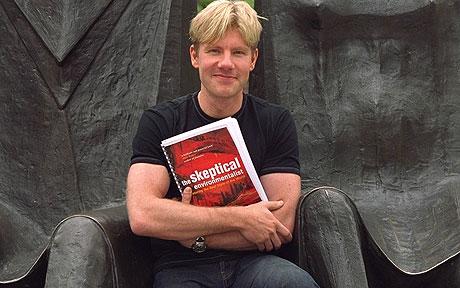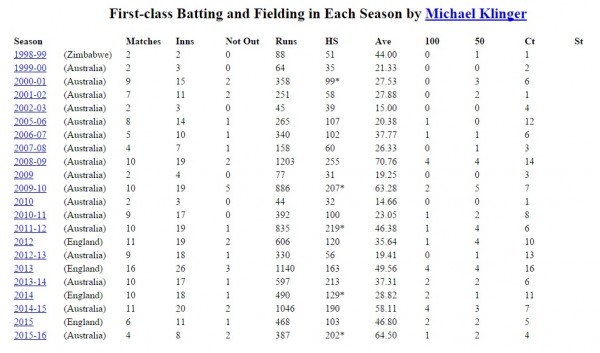
A gradual but inevitable descent into cricket-based loathing and bile.
The Australian National Selection Panel: Deconstructing The Arcane Art Of The ‘Gut Feel’
We always just assumed team selection meetings involved very serious men seated around a table, engaged in the hard work of sifting through all the available evidence to determine which group of players were best suited to winning an upcoming Test series. Turns out that assumption was wrong, and in particular there seems to be less use of evidence – or indeed application of any sort of scientific method – on display in these meetings than there is in the usual Bjørn Lomborg publication. Instead, they generally seem to involve lots of guff about ‘gut feeling’, whatever the hell that means.

Unlike Lomborg, we actually passed statistics at university. On the second try anyway.
Perhaps it was a mistake to think that selectors might take the time to fire up statsguru on cricinfo for a couple of minutes before coming to a decision, because it clearly looks like this isn’t the accepted working method when it comes to the Australian Test team. The call up of Nathan Coulter-Nile, who has played precisely zero Sheffield Shield games this season, was defended on the grounds of gut feel and that other buzz word of Australian cricket: ‘velocity philosophy’. Yeah, we’re not making that up either. It’s the argument that’s used to keep players like Jackson Bird (four Shield games played for 18 wickets at 24.77) on the outer. Have they done any scientific analysis to determine that bowlers who bowl faster than 140kph are better at Test level than those who don’t? You’d assume so, but given our earlier assumption was so wrong, we’re now pretty sure that this is another of those gut feel situations.
Then you have the, frankly, hilarious situation surrounding Michael Klinger, who was overlooked because his career First Class average isn’t high enough. Yes, not his average over the past twelve months, or even twenty-four months, but his career average. By that reckoning, a batsman could average 10 runs for several years (not out of the question if he plays for Tasmania), then average closer to 100 for a couple of seasons, but still be disregarded because his career average would still be fairly ordinarily. Yeah, it’s an extreme example, but it’s also an extremely stupid argument to use against selecting a player.

FAO Australian selectors: this took 30 seconds to find.
This was followed by the, if anything, even more hilarious recall of Shaun Marsh based on the argument that since he was the last bloke kicked out of the team, it would be unfair not to give him first chance at getting back in. Or something. This is the same Shaun Marsh, by the way, who has a worse career First Class average than Michael Klinger. Or how about the call up of Andrew Fekete for the subsequently abandoned tour of Bangladesh? A player who has struggled to make the Tasmanian squad this season such is his poor form. We’re glad this makes some sort of sense to the National Selection Panel, because we’re buggered if it makes any sense to us, and we suspect they are just making things up as they go along.
This question of averages, and the emphasis they are seemingly given by the selectors, also raises an interesting point. During the first Test against New Zealand, Mitchell Marsh threw his wicket away in the second innings chasing quick runs. As opposed to just throwing it away for no reason like he normally does. Usually this would be disregarded, considered as putting the team first, but Chris Rogers raised the interesting point that it could actually be an issue for Marsh, since it further damaged his already rubbish Test batting average, and people put a lot of stock in statistics like that. If not the players themselves, then certainly the media and the fans (like us: you suck Mitch), and now it looks like even selectors do.
If this is the way the selectors are going to look at things, young batsmen would be well served to put their average first, forget about the team and just make sure they get that red inker. Similarly fast bowlers should forget all about maintaining line and length and building pressure, just make sure you get that ball up over 140kph, because now it seems that’s ALL THAT MATTERS.

That painful moment when McGrath realised that since he bowled slower than 140kph, all his 563 Test wickets must have been flukes.
The selectors might argue that relying on the arcane art of the ‘gut feel’ served them well this summer, and, yeah, Usman Khawaja didn’t do a half bad job given the chance. And Shaun Marsh wasn’t completely rubbish. At least not in his second dig. But it’s this sort of half arsed selection jiggery pokery that likely resulted in Australia not picking Peter Siddle till it was far too late in the last Ashes series, or the complete balls up that was Trent Bridge or take your pick from any of Glenn Maxwell’s appearances in a baggy green.
Admittedly, the ‘gut feel’ method occasionally does work, and there is a lot to be said for not giving too much weight to First Class performances given Australian pitches are so different for international games (and by different we mean worse). But still, it would be nice to feel there was a little scientific method being applied in the back room, and the selectors weren’t picking players on the basis of which had the best moustache or was less likely to want to punch David Warner in the face. But it’s increasingly clear our expectations were far too high and the National Selection Panel operates about as efficiently as the American Republican Party, i.e. not very well at all.

No Comments
Post a Comment